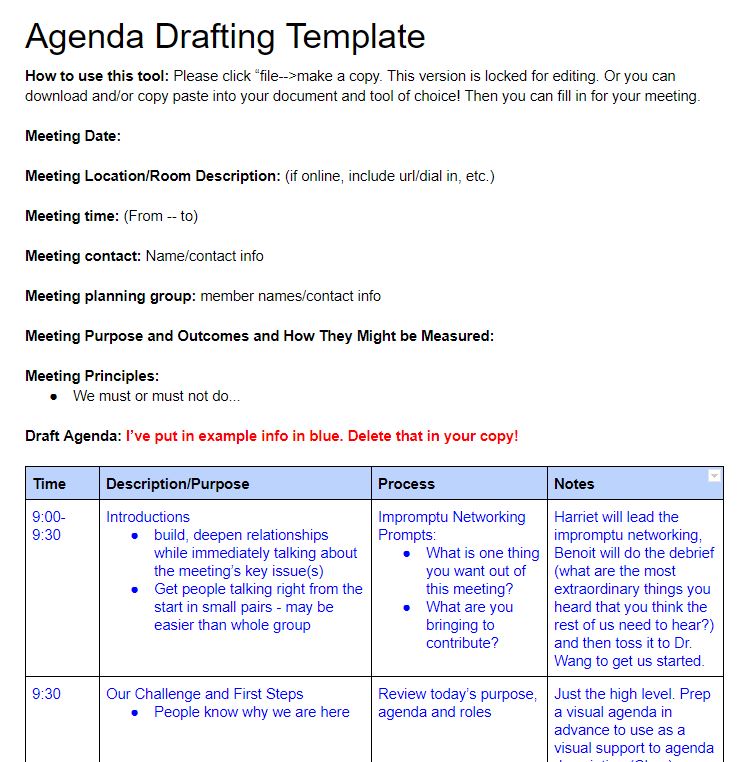A colleague asked me today about how I work with teams who need to develop meeting agendas – hopefully together. As a facilitator, I’m particularly interested not simply doing this FOR a client, but building the capacity for them to do it.
Most facilitators have some version of this process. It is neither innovative nor unique. But for me it has been useful. Today’s request reminded me it might be helpful to share my process here on my (too) sleepy blog.
Below you can skim the process and see a template you can copy in Google Drive to try it yourself! Screen shot below just to spice things up a bit!

- Agree on tangible meeting outcome(s) together. Often I jump start this by asking “by the end of this meeting we want people to think, feel, know and do next…” Get those on the table, prioritized if necessary. Trim down to reality check after the first draft and once drafted, ensure agenda meets these outcomes. It is amazing how often there is not a match! I typically do this on a phone call with the planning team, and work through steps 1 and 2 of this process.
- Design first draft of agenda together. I use a table with the following columns: Time (from x to Y), Description/Purpose (what we want out of this agenda item), Process (how we will do it – more on that in a second) and Notes which includes who leads, who is responsible for any artifacts, etc). I like to do this in a collaborative editing space, NOT IN A CIRCULATING Word doc. I set it up before the planning call and share the URL. This online co-editing is not always an accepted practice, but it makes the process visible and participation (or lack of it) apparent. This visibility is critical in moving from us as consultants or leaders doing the work for them, to us coaching, to us being on call only as needed. It is very helpful when there are at least two members rather than one designing (yay co-chairs). They can use their unique talents together and it also is less risky for them individually.
- Review the agenda with a lens that reflects the values and principles of the group. Note, there is an assumption that a group has these. If not, this might be part of the step 1 conversation. This step does NOT mean we will have designed specific agenda items FOR these principles, but have chosen processes for the work agenda that leverage these things. One lens I frequently use comes from a Communities of Practice (CoP) perspective. It reflects the three parts of a CoP: community, domain and practice. When reviewing the agenda together we ask:
- Is there something in this meeting that allows people to get to know/trust/enjoy each other better (community)? This supports the subsequent actions/follow up.
- Is there something that deepens their domain understanding (domain)? This gives each individual some of their own professional development while participating in a meeting. Value in meetings should accrue in all directions if possible.
- Does each person have a chance to practice what they need to do to execute going forward?
- Reality check against time/resources. Review and simplify where ever possible. I tend to make everything more complicated than it needs to be on first pass. This is where things tighten down.
With some groups there is not a widespread skill set of understanding their process options, how to mix and match them, etc. Good news – a friend and I are running a two day “Liberating Structures Immersion Summer Camp” in July down at Dumas Retreat Center here in Western Washington to teach this stuff. Leave me a note in the comments and I will let you know when the details are released.
Most meeting planning I’m involved in happens in an online video conference room (like Zoom) where we can screen share, see each other and take notes together. Phone is a distant second best. Most people cannot afford the time to do the planning F2F.
In a good working context, one person sketches out the first draft and invites people to review. We have our online meeting to discuss the outcomes, principles and draft. A DIFFERENT PERSON does the second draft with asynchronous online comments. The next online meeting is to prepare execution of meeting. If artifacts need drafting (slides, handouts, share background readings or data) we link those into the agenda so all materials are easily accessed and, where appropriate, shared.
Here is one more tip. While the facilitators’ agenda can be as detailed as you want, only send a summary agenda to participants UNLESS you are trying to build everyone’s meeting facilitation practices. I typically only put general times to avoid the “oh, I can slip out and take my phone call during this agenda item because it doesn’t matter to me.” Uh, no, our goal is that the entire agenda matters to you. If it doesn’t, we are failing.